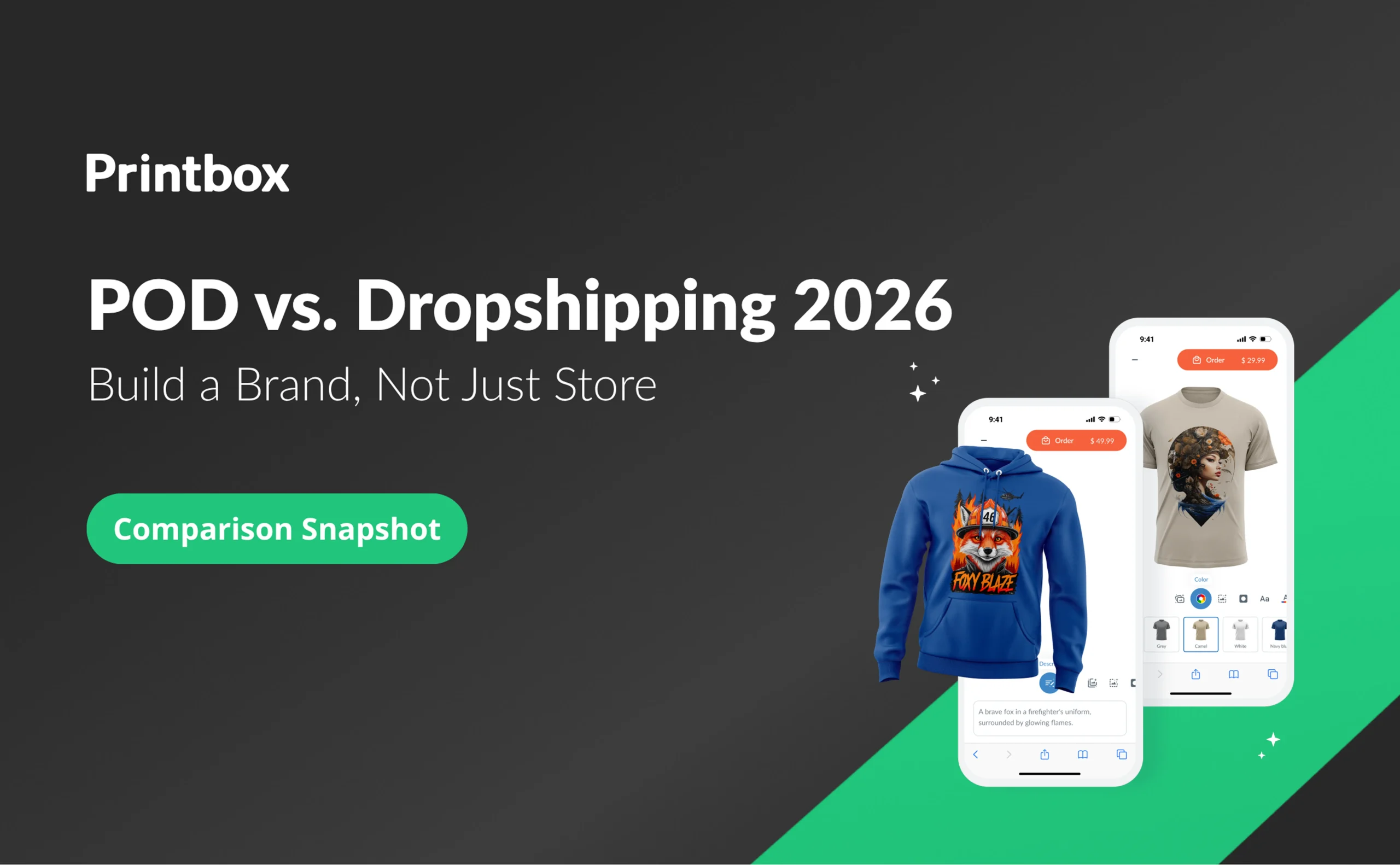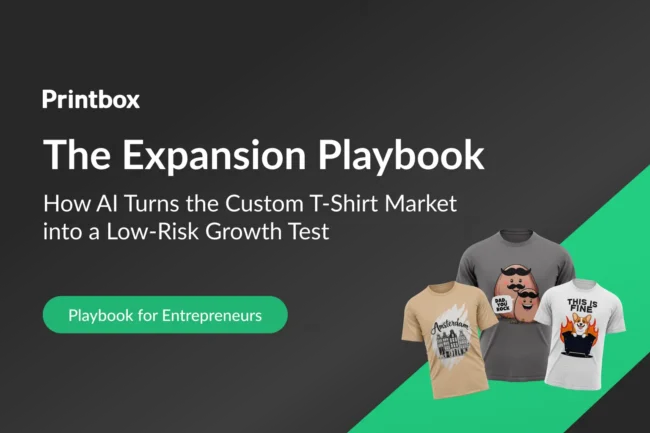Print on Demand vs. Dropshipping: Which E-commerce Model Will Build Your Brand in 2026?
Choosing a business model is the most critical decision you’ll make when starting an e-commerce venture. Two of the most popular, low-risk options are print-on-demand vs dropshipping. Both let you sell products without holding inventory, but they lead to vastly different outcomes. The question of whether to choose print on demand or dropshipping boils down to a fundamental choice: are you building just another online store, or are you building a lasting brand?
This guide will break down everything you need to know to decide. We’ll explore workflows, profitability, and long-term strategy to help you make an informed decision that aligns with your ambitions.
What is Dropshipping? A Beginner’s Guide
Dropshipping is an e-commerce model where the seller acts as a middleman. You list pre-made products from a third-party supplier in your online store. When a customer places an order, you forward it to the supplier, who then ships the product directly to the customer. You never physically handle the goods.
The workflow is simple:
- You find a supplier and list their products (e.g., generic t-shirts, mugs, electronics).
- A customer buys the product from your store.
- You purchase the item from your supplier and provide them with the customer’s shipping details.
- The supplier ships the product directly to the customer.
While this model is popular due to its extremely low startup costs, it comes with significant downsides. Under dropshipping, you have virtually no control over product quality, packaging, or shipping times. This can lead to inconsistent customer experiences and negative reviews. Furthermore, since many other stores are selling the exact same products, you’re often forced into a price war, which crushes profit margins.
What is Print on Demand? Custom Products, Made to Order
Print on demand (POD) is a specialized form of dropshipping where products are only created after a customer places an order. The key difference is that these products are unique and feature your own designs. Instead of selling pre-made items, you sell white-label products (like apparel, posters, or mugs) that are customized with your creative work. This model, sometimes referred to in simple terms as “pod dropshipping”, puts creativity at the forefront.
This model allows you to sell an unlimited range of unique products without worrying about inventory or unsold stock. Print-on-demand and dropshipping both eliminate warehousing, but POD gives you the power of personalization, which is what modern consumers crave.
What Is the Difference Between Dropshipping and Print on Demand?
At first glance, the models seem similar, but the implications for your business are huge. So, what is the difference between dropshipping and print on demand? Understanding this is crucial for your long-term success.
| Aspect | Dropshipping | Print on Demand (POD) |
|---|---|---|
| Product | Generic, mass-produced | Unique, personalized, with your design |
| Brand Control | Minimal (packaging and product from supplier) | Full (your brand on the product and packaging) |
| Barrier to Entry | Very low | Low (requires creating designs) |
| Profit Margins | Low (price competition) | Higher (product uniqueness justifies the price) |
| Niche Building | Hard to build (you sell what others sell) | Easy to build (based on your creativity) |
| Customer Loyalty | Low (customer looks for the lowest price) | High (customer is connected to your brand and design) |
The core of the dropshipping vs print on demand debate comes down to value. With dropshipping, you sell someone else’s product. With POD, you sell your product. A deeper look at what is the difference between dropshipping and print on demand reveals it’s about control and brand equity. Even a seemingly simple product category like dropshipping photo prints is limited to reselling existing posters, whereas a print on demand dropship model allows customers to create their own unique wall art, transforming a simple purchase into a creative experience.
What are the Pros and Cons of Print on Demand?
Pros:
- Total Brand Control: Your designs, your brand, your packaging. You control the entire customer experience.
- No Inventory Risk: Products are made to order, eliminating the cost and risk of unsold stock. This is also a more sustainable model, reducing waste.
- Limitless Creativity: You can test new designs, react to trends, and build a massive catalog with zero upfront cost. With AI image generation tools, you can create thousands of unique designs in seconds, keeping your offer fresh and exciting.
- High Customer Engagement: Personalization creates an emotional connection, turning buyers into loyal fans.
- Higher Perceived Value: Unique, custom products command higher prices than generic goods.
Cons:
- Longer Fulfillment Times: Products must be printed before they are shipped, which can add a few days to the delivery time compared to pre-made dropshipped items.
- Higher Product Costs: The cost per item is naturally higher than bulk-produced goods, which can affect initial margins.
- Design Responsibility: The success of your store rests on the quality and appeal of your designs.
Is Print on Demand Profitable?
Absolutely. While the cost-per-item in POD might be higher, the profitability comes from building a brand, not just selling a product. Instead of competing on price, you compete on uniqueness. Successful POD businesses focus on building a strong niche and a loyal following. Because your products are exclusive, you can set premium prices that customers are willing to pay. This model moves you away from the “race to the bottom” associated with a simple “pod dropshipping” approach and allows you to build a sustainable, profitable business.
Is Print on Demand Better for Beginners?
When making the choice between print-on-demand and dropshipping, beginners often face a paradox. Dropshipping seems easier to start – just find a product and list it. However, it’s much harder to succeed in. You’re a small fish in a massive ocean of identical stores.
Print on demand, on the other hand, allows beginners to build a defensible moat around their business from day one: their brand. The debate of dropshipping vs print on demand is really about short-term tactics versus long-term strategy. By creating a unique aesthetic and serving a specific niche, you can attract a dedicated audience that can’t find your products anywhere else. It requires more creative effort upfront, but it’s a far more strategic path for long-term growth.
Conclusion: Choose the Model That Builds an Asset
So, when it comes to the dropshipping vs print on demand debate, the right choice depends on your ambition. You have to ask yourself what is the difference between dropshipping and print on demand in terms of the business you want to build. If you’re looking for a quick, low-effort way to make a few sales, the dropshipping model might suffice. But if your goal is to build a real, valuable business – an asset with a loyal customer base and a strong brand identity – the choice between print on demand or dropshipping becomes clear.
Print on demand is the superior model for creators, brand-builders, and entrepreneurs who want to sell something unique. It empowers you to turn your creativity into a scalable and profitable e-commerce business.
Ready to Build Your Brand with Print on Demand?
Choosing the right model is the first step. The next is choosing the right technology partner. Printbox provides an enterprise-grade, flexible platform designed to help ambitious brands scale without limitations. We’re more than just software; we’re a partner in your growth.
If you’re serious about building a successful personalization business, let’s talk strategy. Contact our team today to discuss your project and discover how Printbox can help you achieve your goals.
Which model is more profitable: dropshipping or print on demand?
At first glance, dropshipping might seem more profitable due to the lower unit costs of mass-produced goods. However, in practice, this leads to price wars and very low margins. Print on demand (POD), despite potentially higher unit costs, allows for much greater long-term profitability. This is because the uniqueness and personalization of the product justify higher prices, build customer loyalty, and help avoid direct price competition. Profitability in POD comes from brand value, not from the sales volume of generic products.
Is print on demand scalable for a large business?
Yes, absolutely. Scalability in the print-on-demand model is not a limitation of the model itself but a technological challenge. Modern, advanced POD platforms like Printbox are designed from the ground up for large e-commerce players and handling huge order volumes. They are based on a scalable cloud architecture (e.g., Google Cloud Platform), automated production processes, and a global network of printing houses, which ensures reliability, speed, and enterprise-level performance.
For which market niches is print on demand a better choice than dropshipping?
Print on demand is the ideal choice for niches where uniqueness, creativity, and brand identity are key. It excels in segments such as:
- Artists, illustrators, and designers: They can monetize their creativity without investing in printing.
- Apparel and lifestyle brands: It allows for the creation of unique collections and building a strong visual identity.
- Photographers: It enables the sale of their work as posters, canvases, or albums, offering customers personalized products.
- Influencers and online creators: They can offer their communities personalized merch, strengthening the bond with their fans.
- Companies (B2B): It allows for the creation of personalized gifts for employees and clients, which builds relationships and the company's image.




